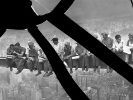Eye For Film >> Movies >> Men At Lunch (2012) Film Review
Men At Lunch
Reviewed by: Jennie Kermode

In 1932 a photograph was taken of 11 men sitting on a beam, eating their lunch, 800 feet above New York City. It has gone on to become one of the most famous images in the world, an iconic summation of the boldness that made the Big Apple possible. Material like this is ripe for cinematic exploration. Unfortunately this film is about 40 minutes longer than it needs to be, and pads itself out by repeating what I've noted in this opening paragraph again and again and again.
A film like this should have a drinking game (take a swig for 'iconic', down the lot for 'speaks to the immigrant experience'; you'll be rolling on the floor by the end). Indeed, that might suit its theme - one of the men, at the near end of the beam, is clearly holding a whiskey bottle. It's a shame, though, because there is some interesting work here that deserves attention, and viewers who love the picture will enjoy hearing about its backstory.

Within that story, there are two key mysteries. Who was the photographer, and who were the men? The film makes an impressive case for identifying two of the latter, and has some strong suggestions for the former. Curiously, no one seems to have looked into the fingerprints on images taken that day, which really stand out on the big screen. As fingerprints are partially hereditary they could provide a vital clue. There is, however, plenty of other impressive detective work to explore, and as the film does so we get a glimpse of an untold story - that of the newspaper snappers who, like the picture's heroes, risked their lives out there on the beams. Their artistry so little appreciated that they weren't even credited, they are shown here balancing on two inch girders in their fashionable, smooth-soled shoes, with bags full of glass plates on their backs. We are reminded that some four percent of ironworkers in the period fell to their deaths; many more were horrifically injured. They got the equivalent of minimum age but, in the Great Depression, many envied them for that.
The bravery of immigrants, many of whom had take one-way tickets from the Old World and abandoned everything they knew in pursuit of a dream, is rightly celebrated here, but the film has a streak of naivety that distorts the story. We hear about their bold ambitions and see how much better their descendants are doing - a tale of people rising upward in the metaphorical sense (and perhaps literally, as higher level apartments in the city are preferred, having fewer cockroaches). What is elided is that a new generation of impoverished immigrants has now taken their place down in the grime and the gutters. There is always a desperate somebody doing the equivalent of walking those beams.
Here there are hints of more interesting stories - the positive effect of Prohibition, for instance, in bringing together rich and poor so that speakeasy friendships reshaped the city's class system. Architectural ambition is explored as a product of culture but the film would have benefited from more exploration of just how the skyscrapers were built. Too often we return to those initial reiterations and to an insistence that the men on the beam somehow represent the spirit of the whole city. It's a poorly supported proposition, ultimately echoing tragedy - everybody adores those men now, but back then they took for granted the low value placed on their lives. As much as this is a tale of courage, it's a tale of celebrated exploitation, and nobody here seems willing to consider that.
Reviewed on: 17 Feb 2013

















